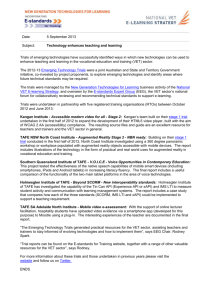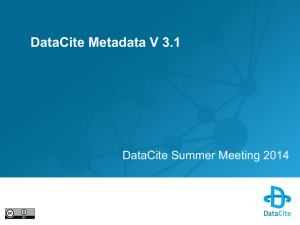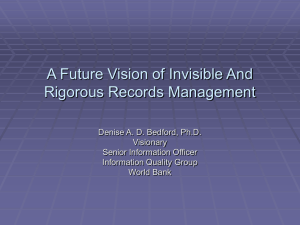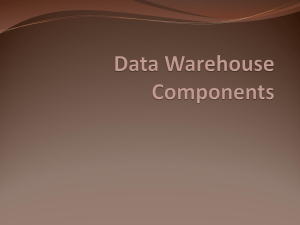Vetadata Metadata Application Profile, Schema and User Guide
advertisement
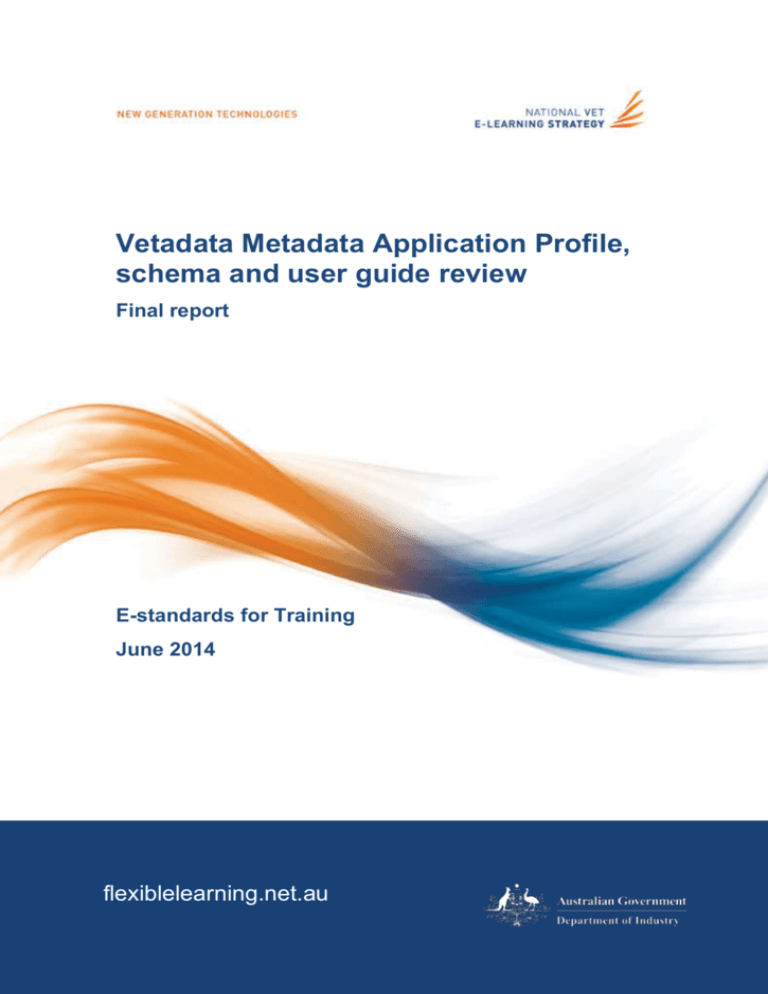
Vetadata Metadata Application Profile, schema and user guide review Final report E-standards for Training June 2014 flexiblelearning.net.au Vetadata Metadata Application Profile, schema and user guide review Final report Disclaimer The Australian Government, through the Department of Industry, does not accept any liability to any person for the information or advice (or the use of such information or advice) which is provided in this material or incorporated into it by reference. The information is provided on the basis that all persons accessing this material undertake responsibility for assessing the relevance and accuracy of its content. No liability is accepted for any information or services which may appear in any other format. No responsibility is taken for any information or services which may appear on any linked websites. With the exception of the Commonwealth Coat of Arms, the Department’s logo, any material protected by a trade mark and where otherwise noted all material presented in this document is provided under a Creative Commons Attribution 3.0 Australia (http://creativecommons.org/licenses/by/3.0/au/) licence. New Generation Technologies incorporating E-standards for Training National VET E-learning Strategy Vetadata Metadata Application Profile, schema and user guide review Final report Table of Contents 1 Purpose .............................................................................................................. 1 2 Outputs .............................................................................................................. 1 2.1 Approach ................................................................................................................ 1 2.2 Notable amendments to the Vetadata standard ................................................. 2 2.3 Identification of further work required ................................................................. 2 3 Future directions for Vetadata.......................................................................... 3 3.1 Learning Resource Metadata Initiative (LRMI) .................................................... 4 3.2 Metadata for Learning Resources (MLR)............................................................. 4 3.3 Conclusion ............................................................................................................. 5 4 Recommendations ............................................................................................ 6 5 Further reading .................................................................................................. 6 More Information .................................................................................................. 7 New Generation Technologies incorporating E-standards for Training National VET E-learning Strategy Vetadata Metadata Application Profile, schema and user guide review Final report 1 Purpose Vetadata is the Australian Vocational Education and Training (VET) sector’s national Metadata Application Profile (MAP). The National VET E-learning Strategy’s New Generation Technologies business activity commissioned this review of the Vetadata documentation to ensure the specification retains its currency for the sector. In response, the following Vetadata documentation and resources have been reviewed and updated: VET Metadata Application Profile Vetadata User Guide Vetadata examples Vetadata XML schema bindings. All documentation has been reviewed by a Vetadata reference group and is ready for publication once it has been endorsed by the E-standards Expert Group. 2 Outputs As per the consultant’s brief for this work, the project has produced the following outputs: An updated Vetadata (Metadata) Application Profile document A set of schema files that correspond with the new MAP and allow for validation of metadata files An updated version of the “Applying Vetadata to Learning Resources” user guide Examples of populated Vetadata files to accompany the user guide and be published on the E-standards website. 2.1 Approach The Vetadata documentation was reviewed in collaboration with a Vetadata reference group: Irvin Flack (TAFE NSW) Felicity Hanrahan (eWorks, Victoria) David Appleby (Westone, WA) Megan Vanderzwan (Department of Education, Training and Employment QLD) Peter Higgs (Tasmania) This group of metadata experts was nominated by E-standards Expert Group members. Further consultations were undertaken with staff responsible for the national collection of Toolbox learning objects and the VET Commons project. National VET E-learning Strategy New Generation Technologies incorporating E-standards for Training Page 1 Vetadata Metadata Application Profile, schema and user guide review Final report 2.2 Notable amendments to the Vetadata standard Removal of the myfuture vocabulary The myfuture vocabulary is no longer supported or maintained and was replaced by the ANZSIC (Australia and New Zealand Standard Industry Classification) vocabulary1. ANZSIC is maintained by the Australian Bureau of Statistics and is used by key national VET organisations. Removal of redundant references A number of redundant references was removed, particularly to the defunct LORN repository network as well as some references to Toolbox learning objects that were no longer relevant. Modification of the mandatory elements Previously the documentation recommended a minimum set of elements, plus a larger set for LORN learning objects. The minimum set has been retained, and a revised set of recommended elements has now been recommended for learning objects that are to be shared nationally. Amendment to Learning Resource Type element The documentation was revised to recommend users enter the relevant Vetadata Educational Use vocabulary term/s first, followed by the associated IEEE LOM term. This change is should make it easier for users to complete this metadata element. 2.3 Identification of further work required The project identified two other pieces of potential future work to consider: Mapping with the Schools sector’s ANZ-LOM specification Investigating the requirements of the Australian Skills Quality Authority (ASQA) and implications for Vetadata ANZ-LOM mapping A mapping between Vetadata and the Schools sector’s ANZ-LOM can be used to facilitate the sharing and exchange of resources between the two sectors. A mapping was previously undertaken between Vetadata and ANZ-LOM but as both specifications have evolved, an updated mapping is required to facilitate interoperability between the two specifications. If a mapping is undertaken, it would also be important to notify potential users of its existence. ASQA Requirements and Vetadata Vetadata currently allows a resource to be classified as either “assessment guides and tools” or an “assessment item”. Aside from specifying more detail in the resource description, Vetadata does not currently provide a structured approach to describing resources as assessment items: 1 http://www.abs.gov.au/AUSSTATS/abs@.nsf/mf/1292.0/ National VET E-learning Strategy New Generation Technologies incorporating E-standards for Training Page 2 Vetadata Metadata Application Profile, schema and user guide review Final report Vetadata Educational Use term Definition Usage assessment guides and tools Resources used to assist or instruct trainers / delivery agents / assessors in assessing a learner’s competency. Can also be used for Recognition of Current Competency. Use for: Assessor Resource; Assessor Guide; Assessment Guideline; Evaluation Criteria assessment item Actual assessment instruments used to evaluate or assess competency. eg assignment description, essay topic, questions, project, questionnaire, quiz, short answers etc. Use for: Self Assessment Checklist; Assessment Instrument; Use: Assessment Guides and Tools for teacher/trainer/delivery agent guides, guidelines, manuals etc. Further work is required to understand what the potential impact of the recently formed ASQA body may have on the information that the sector should be recording about assessment items. The Vetadata specification may need to be modified to accommodate these new requirements. 3 Future directions for Vetadata The Vetadata standard has been successfully implemented across the sector and has been an important contributor in enabling the sharing and discovery of learning resources. The review of Vetadata at this time was relatively minor, with no significant changes proposed to the structure of the Vetadata standard itself. This is appropriate at this time, as metadata standards for learning resources have remained fairly static since the publication of the IEEE LOM in 2002. There are 3 commonly used metadata standards (and their derivatives) in education: IEEE LOM, IMS and Dublin Core metadata. The IMS metadata profile was intended to be superseded by IEEE LOM, but due to the enduring popularity of SCORM 1.2, it remains in wide use. Each of these approaches provides for a hierarchical approach to describing learning resources, which may be thought restrictive by current web users. The Vetadata standard is based on IEEE LOM, and also supports IMS metadata for SCORM 1.2 learning objects. The relative complexity of these standards can sometimes cause confusion for non-expert users when creating metadata for learning resources. Two recent international efforts in the learning resource metadata space may result in significant changes to the way learning resources are described in future. The first is the Learning Resource Metadata Initiative (LRMI), which proposes a new approach to describing resources. The second is an exercise in rationalisation between two existing metadata approaches (IEEE LOM and Dublin Core). National VET E-learning Strategy New Generation Technologies incorporating E-standards for Training Page 3 Vetadata Metadata Application Profile, schema and user guide review Final report 3.1 Learning Resource Metadata Initiative (LRMI) The Learning Resource Metadata Initiative (LRMI)2 is a project led by Creative Commons (CC) and the Association of Educational Publishers (AEP) to establish a common vocabulary for describing learning resources. The Association of Educational Publishers is an association of publishers, which includes McGraw-Hill Education, Scholastic and Pearson. Very broadly, the aim of the LRMI is to make it easier to publish and find learning content. The LRMI approach is based on the schema.org initiative, a collaboration between Google, Bing and Yahoo! that was launched in 2011. Schema.org is a specification for adding information to web content that can be read and understood by search engines (and potentially other systems too including for example learning object repositories). LRMI is the first ”industry specific” implementation of the schema.org specification. Although not yet widely implemented, the most common approach to creating schema.org metadata is to encode HTML pages as microdata. Microdata adds attributes to the HTML elements of web content, which can be used by software and services to understand the meaning of the content. A simple example is as follows: My name is <span itemprop="name">John Smith</span> The itemprop=”name” attribute indicates that this text is a person’s name. Generally microdata is used to describe the human readable information on a web page in a way that can be understood by software and systems. The approach would result in a significant shift in the way learning resources are described. Before it could be widely used, it would require the development of new software tools to enable teachers, trainers and others to mark up learning resources in this way. The LRMI approach has a number of potential benefits: Learning content could be easier to find by search engines More fine-grained searching would be potentially possible – including searching inside learning objects for example Subject to access to appropriate software tools and support, metadata creation could be simplified for creators of learning resources The education community could utilize tools and resources created through the broader schema.org community. 3.2 Metadata for Learning Resources (MLR) Metadata for Learning Resources (MLR) is a draft ISO standard designed to harmonise the IEEE LOM and Dublin Core metadata standards. It is an ISO standard 2 http://www.lrmi.net/ National VET E-learning Strategy New Generation Technologies incorporating E-standards for Training Page 4 Vetadata Metadata Application Profile, schema and user guide review Final report (ISO/IEC 19788) with the framework being published in 20113 as a draft. A mapping has been created from the IEEE LOM to MLR (19788-3, Annex C1), and it is expected that MLR will replace the IEEE LOM standard, with no further development expected on the IEEE LOM. The publication of this standard addresses the previous lack of interoperability between the IEEE LOM and Dublin Core. Like LRMI, MLR has not yet been widely implemented and it is not possible to predict if it will become a commonly used approach for describing learning resources. MLR is fully compliant with the Resource Description Framework (RDF)4. RDF is a generic semantic web standard for describing concepts and resources and modelling information, which organises data into triples. Each triple has the following format: Subject-Predicate-Object An example is: Learning object X (subject) contains resources related to (predicate) training package Y (object). This approach to describing resources has the potential for greater flexibility, as resources and objects can be defined and then related to each other in more detailed and sophisticated ways that would be very difficult or impossible to achieve with the hierarchical XML-based approach to metadata. However, it is a fundamentally different approach to describing resources and would therefore require significant change to implement. This would include the development or modification of software tools for creating and using metadata, as well as training and support for metadata generation. The MLR standard is not required to be implemented with RDF (the standard itself is technology-neutral), however it seems very likely that RDF will be the default way MLR will be implemented in practice. Potential benefits include: Addressing many of the unnecessary complexities of the IEEE LOM Greater allowance for localisation and customisation Interoperability with IEEE LOM and Dublin Core metadata means it is easier to create cross-walks and mappings between different metadata application profiles, which means it should be easier to share data across educational communities. Greater flexibility in describing resources and their relationships. 3.3 Conclusion It is too early to determine whether the education community will take up either of these two very different approaches. Implementation will require support from tool and software vendors including Learning Management Systems and repository systems. The enduring popularity of the SCORM 1.2 specification shows that it can be very difficult to implement change in the technical standards used by the sector, due to the cost and effort involved. 3 4 See: http://www.cen-ltso.net/main.aspx?put=991&AspxAutoDetectCookieSupport=1 http://www.w3.org/RDF/ National VET E-learning Strategy New Generation Technologies incorporating E-standards for Training Page 5 Vetadata Metadata Application Profile, schema and user guide review Final report Both approaches would offer benefits in being able to describe learning resources more flexibly, however neither approach has gained significant traction in the community at this stage. The E-standards Expert Group should retain a watching brief over developments in the metadata space and should revisit this topic in 2015 to determine whether any further action is required. 4 Recommendations Recommendation 1: Publish updated Vetadata documentation and notify relevant user groups Recommendation 2: To facilitate interoperability between the Schools and VET sectors, a mapping should be undertaken between ANZ-LOM and Vetadata. Recommendation 3: Investigate ASQA requirements for identifying and describing assessment items and related evidence of assessment, to determine the implications for the Vetadata specification. Recommendation 4: The EEG maintains a watching brief on the LRMI and MLR initiatives and reviews their status again in 6-12 months time. Recommendation 5: The EEG considers one or both of the following actions in 2015 if deemed appropriate at that time: A trial for marking up a sample of learning objects using LRMI A mapping between Vetadata and MLR. 5 Further reading Information about schema.org: http://publications.cetis.ac.uk/2014/960 Blog post on MLR and LRMI: http://elearningstandards.wordpress.com/2012/05/31/metadata-acronyms-mlr-or-lrmi/ Information about RDF: http://www.w3.org/RDF/ LRMI website: www.lrmi.net MLR website: http://www.iso.org/iso/catalogue_detail.htm?csnumber=50772 National VET E-learning Strategy New Generation Technologies incorporating E-standards for Training Page 6 Vetadata Metadata Application Profile, schema and user guide review Final report More Information National VET E-learning Strategy Email: flag_enquiries@natese.gov.au Website: flexiblelearning.net.au New Generation Technologies incorporating E-standards for Training Email: e-standards@flexiblelearning.net.au Websites: New Generation Technologies: ngt.flexiblelearning.net.au E-standards for Training: e-standards.flexiblelearning.net.au National VET E-learning Strategy New Generation Technologies incorporating E-standards for Training Page 7
